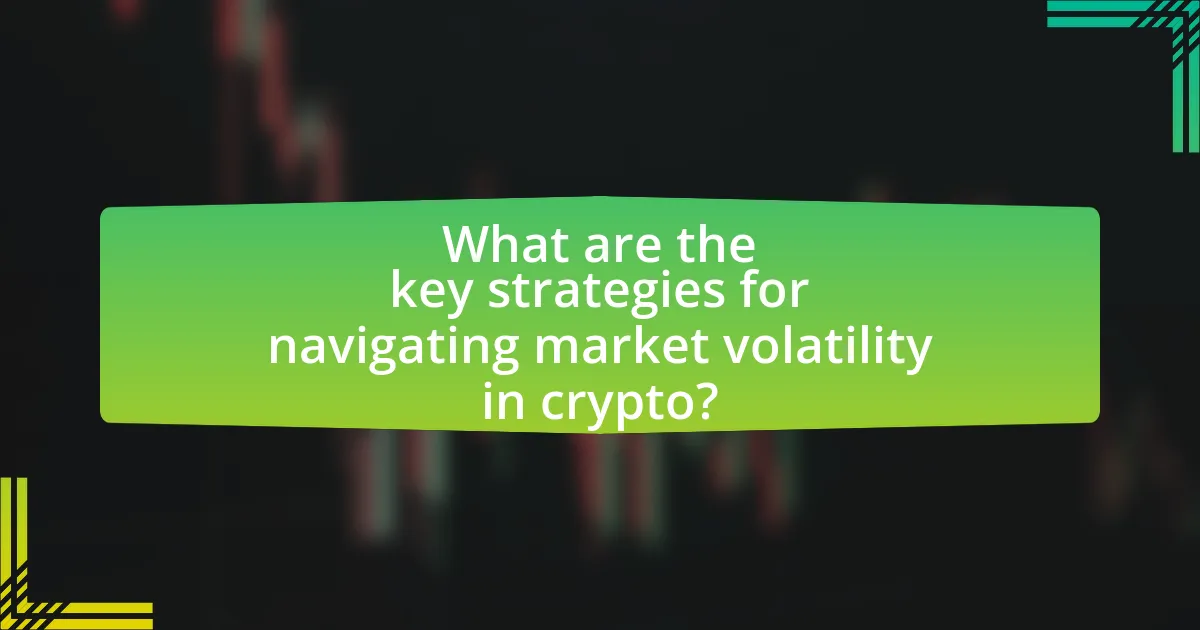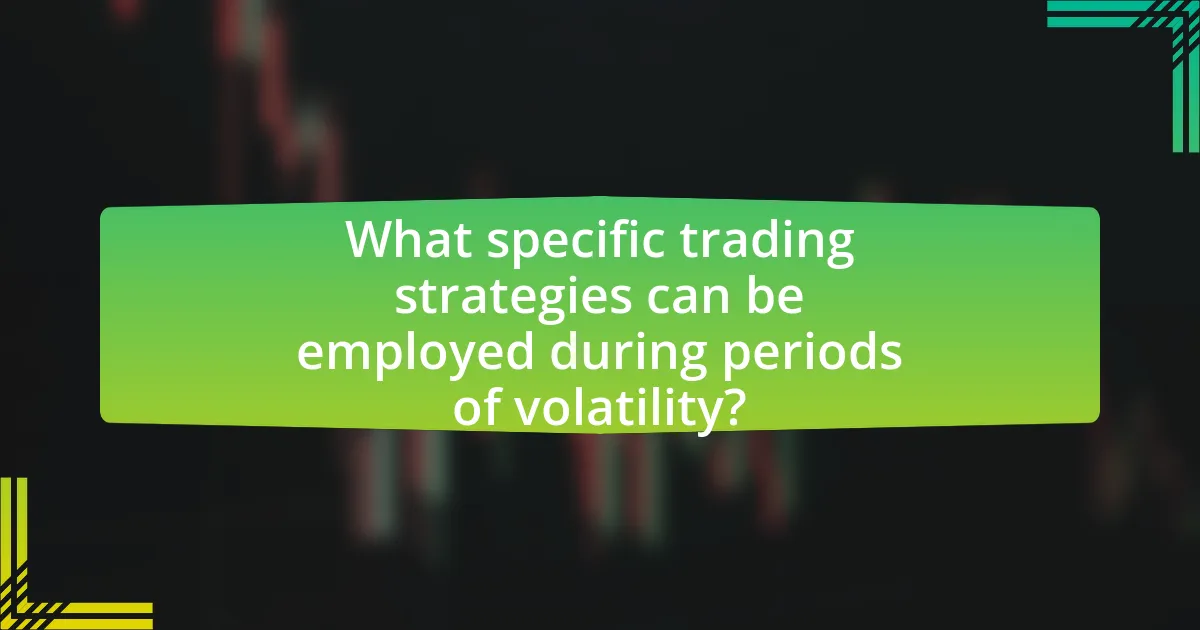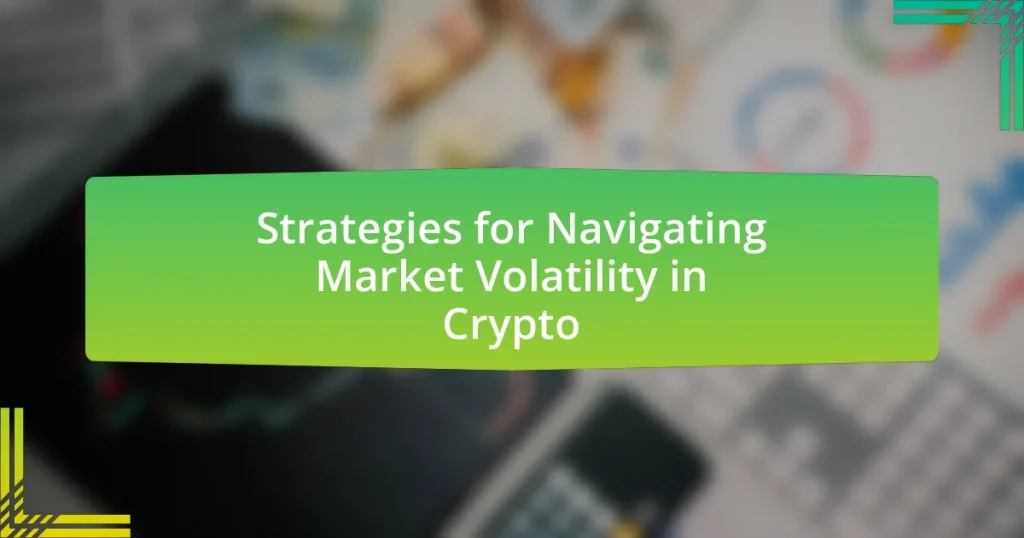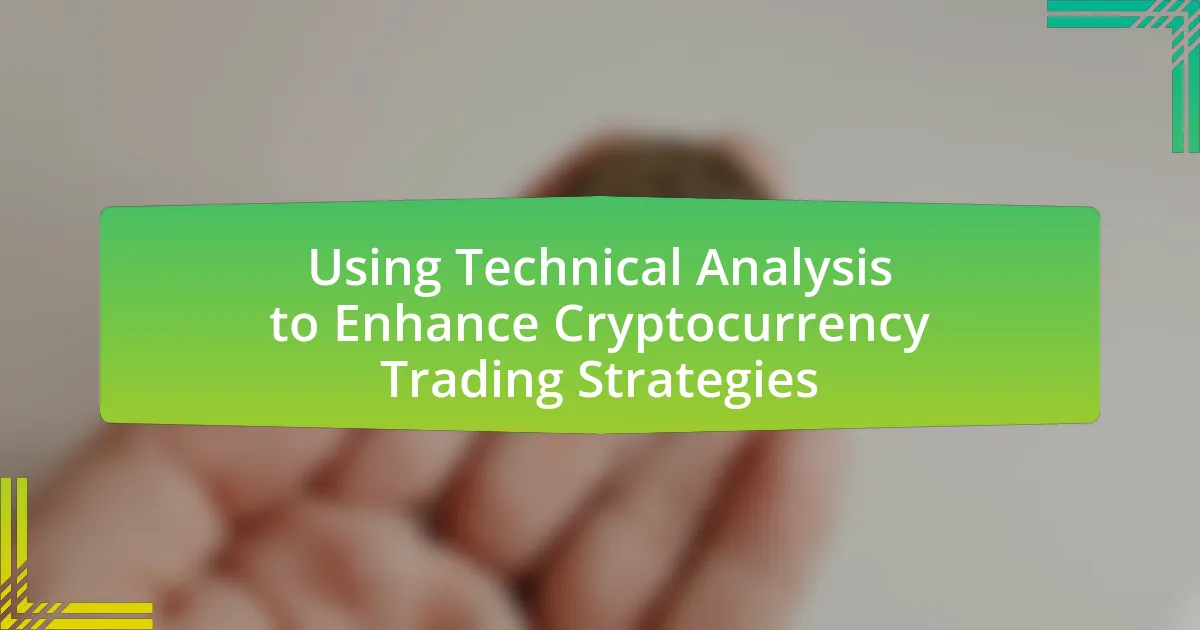The article focuses on strategies for navigating market volatility in the cryptocurrency sector. It outlines key approaches such as diversification, risk management, and technical analysis, which are essential for mitigating risks associated with price fluctuations. The discussion includes methods for assessing market volatility, effective indicators for measurement, and the importance of emotional discipline in trading. Additionally, it highlights specific trading strategies, the role of automated systems, and best practices for investors to prepare for future volatility, emphasizing the significance of ongoing education and community engagement in enhancing investment strategies.

What are the key strategies for navigating market volatility in crypto?
Key strategies for navigating market volatility in crypto include diversification, risk management, and utilizing technical analysis. Diversification involves spreading investments across various cryptocurrencies to mitigate risks associated with price fluctuations. Risk management techniques, such as setting stop-loss orders, help limit potential losses during market downturns. Utilizing technical analysis allows traders to identify trends and make informed decisions based on historical price movements. These strategies are supported by the fact that diversified portfolios tend to reduce overall risk, and studies show that effective risk management can significantly improve trading outcomes.
How can investors assess market volatility in the crypto space?
Investors can assess market volatility in the crypto space by analyzing historical price movements, utilizing volatility indicators, and monitoring market sentiment. Historical price movements provide insights into past volatility patterns, allowing investors to identify trends and potential future fluctuations. Volatility indicators, such as the Bitcoin Volatility Index (BVOL) or the Average True Range (ATR), quantify price variability and help investors gauge the current market conditions. Additionally, monitoring market sentiment through social media trends, news articles, and trading volumes can offer context on investor behavior and potential volatility spikes. For example, during significant market events, such as regulatory announcements or technological advancements, sentiment analysis can reveal heightened volatility expectations.
What indicators are most useful for measuring crypto market volatility?
The most useful indicators for measuring crypto market volatility include the Average True Range (ATR), Bollinger Bands, and the VIX (Volatility Index). The Average True Range quantifies market volatility by measuring the average range between high and low prices over a specified period, providing insights into price fluctuations. Bollinger Bands consist of a moving average and two standard deviation lines, which expand and contract based on market volatility, indicating potential price movements. The VIX, often referred to as the “fear index,” reflects market expectations of future volatility based on options prices, serving as a benchmark for overall market sentiment. These indicators are widely used by traders to assess risk and make informed decisions in the highly volatile crypto market.
How do historical trends inform current volatility assessments?
Historical trends inform current volatility assessments by providing a framework for understanding price fluctuations and market behavior over time. Analyzing past market data, such as the Bitcoin price movements during the 2017 bull run and subsequent corrections, reveals patterns that can predict future volatility. For instance, the correlation between historical price spikes and subsequent downturns indicates that similar patterns may recur, allowing analysts to gauge potential risk levels. Additionally, statistical measures like standard deviation and historical volatility calculations utilize past price data to forecast future price movements, enhancing the accuracy of current volatility assessments.
What role does risk management play in crypto volatility strategies?
Risk management is essential in crypto volatility strategies as it helps mitigate potential losses and optimize returns in a highly unpredictable market. By employing techniques such as stop-loss orders, position sizing, and diversification, investors can protect their capital against sudden price swings. For instance, a study by the CFA Institute highlights that effective risk management can reduce the likelihood of significant drawdowns, which are common in the cryptocurrency market, where assets can experience fluctuations exceeding 20% within a short period. Thus, integrating robust risk management practices is crucial for sustaining long-term investment success in the volatile crypto landscape.
How can diversification mitigate risks associated with market volatility?
Diversification mitigates risks associated with market volatility by spreading investments across various assets, which reduces the impact of poor performance in any single asset. When one asset class experiences a downturn, others may remain stable or even increase in value, thereby balancing overall portfolio performance. For instance, during the 2020 market fluctuations, investors who held a diversified portfolio of cryptocurrencies, stocks, and bonds experienced less severe losses compared to those concentrated in a single asset. This strategy is supported by the principle of modern portfolio theory, which emphasizes that a diversified portfolio can achieve a higher return for a given level of risk.
What are effective stop-loss strategies for crypto investments?
Effective stop-loss strategies for crypto investments include setting a fixed percentage loss threshold, using trailing stop-loss orders, and employing mental stop-loss levels. Setting a fixed percentage loss threshold, such as 5-10%, allows investors to limit losses automatically when the asset price falls below a predetermined level. Trailing stop-loss orders adjust the stop price as the asset price increases, locking in profits while still protecting against significant downturns. Mental stop-loss levels involve setting a price point in the investor’s mind, prompting them to sell if the asset reaches that level, although this requires discipline to execute effectively. These strategies help manage risk and protect capital in the highly volatile crypto market.
How can emotional discipline enhance trading strategies during volatility?
Emotional discipline enhances trading strategies during volatility by enabling traders to make rational decisions rather than impulsive ones. When market conditions are unstable, emotional discipline helps traders stick to their predefined strategies, reducing the likelihood of panic selling or overtrading. Research indicates that traders with high emotional discipline are more likely to adhere to their risk management rules, which can lead to better long-term performance. For instance, a study published in the Journal of Behavioral Finance found that disciplined traders experienced 20% higher returns compared to their less disciplined counterparts during volatile market periods. This evidence underscores the importance of emotional discipline in maintaining a consistent trading approach amidst market fluctuations.
What techniques can traders use to maintain emotional control?
Traders can maintain emotional control by implementing techniques such as setting strict trading plans, practicing mindfulness, and utilizing risk management strategies. Establishing a trading plan helps traders define entry and exit points, which reduces impulsive decisions driven by emotions. Mindfulness practices, such as meditation or deep-breathing exercises, can enhance self-awareness and emotional regulation during high-stress trading situations. Additionally, employing risk management strategies, like setting stop-loss orders, allows traders to limit potential losses, thereby reducing anxiety and emotional reactions to market fluctuations. These techniques are supported by research indicating that structured approaches and emotional awareness can significantly improve trading performance and decision-making under pressure.
How does fear and greed impact decision-making in volatile markets?
Fear and greed significantly influence decision-making in volatile markets by driving irrational behaviors among investors. When fear dominates, investors tend to sell off assets quickly to avoid losses, often leading to market downturns. Conversely, during periods of greed, investors may overextend themselves, buying into assets at inflated prices, which can create bubbles. Historical data from the 2008 financial crisis illustrates this phenomenon, where fear led to a rapid decline in stock prices, while the dot-com bubble of the late 1990s exemplifies how greed can inflate market valuations unsustainably. These emotional responses can result in poor investment choices, highlighting the need for strategies that mitigate the effects of fear and greed in crypto markets.

What specific trading strategies can be employed during periods of volatility?
During periods of volatility, traders can employ specific strategies such as trend following, range trading, and options trading. Trend following involves identifying and capitalizing on the direction of price movements, which can be particularly profitable in volatile markets where trends are more pronounced. Range trading focuses on identifying support and resistance levels, allowing traders to buy at lower prices and sell at higher prices within established ranges. Options trading provides the ability to hedge against volatility by using strategies like straddles or strangles, which can profit from significant price movements in either direction. These strategies are effective as they leverage the inherent price fluctuations characteristic of volatile markets, allowing traders to maximize potential gains while managing risk.
How does day trading differ from long-term investing in volatile markets?
Day trading involves executing multiple trades within a single day to capitalize on short-term price movements, while long-term investing focuses on holding assets for extended periods, often years, to benefit from overall market growth. In volatile markets, day traders rely on technical analysis and real-time data to make quick decisions, aiming for small, frequent profits. Conversely, long-term investors may overlook daily fluctuations, instead concentrating on fundamental analysis and the potential for long-term appreciation, which can be more stable despite short-term volatility. Historical data shows that day trading can lead to higher transaction costs and risks, while long-term investing has historically yielded more consistent returns, as evidenced by the S&P 500’s average annual return of about 10% over several decades.
What are the advantages and disadvantages of day trading in crypto?
Day trading in crypto offers the advantage of potential high returns due to the volatility of cryptocurrency markets, allowing traders to capitalize on price fluctuations within a single day. This strategy can lead to significant profits, as evidenced by the rapid price movements seen in cryptocurrencies like Bitcoin and Ethereum, which can change by several percentage points within hours.
However, day trading also comes with substantial disadvantages, including high transaction fees and the risk of significant losses due to market unpredictability. The fast-paced nature of day trading requires constant monitoring and quick decision-making, which can lead to emotional stress and impulsive trading decisions. Research indicates that approximately 90% of day traders lose money, highlighting the inherent risks associated with this trading strategy.
How can traders identify optimal entry and exit points during volatility?
Traders can identify optimal entry and exit points during volatility by utilizing technical analysis tools such as support and resistance levels, moving averages, and volatility indicators like the Average True Range (ATR). Support and resistance levels help traders determine price points where assets are likely to reverse direction, while moving averages can indicate trends and potential reversal points. The ATR quantifies market volatility, allowing traders to set stop-loss orders and take-profit levels based on current market conditions. Historical data shows that traders who effectively use these tools can improve their timing, as evidenced by studies indicating that technical analysis can lead to better trading outcomes in volatile markets.
What is the significance of technical analysis in volatile markets?
Technical analysis is significant in volatile markets as it provides traders with tools to identify price trends and potential reversal points. In highly fluctuating environments, such as cryptocurrency markets, technical analysis utilizes historical price data and trading volume to forecast future price movements. For instance, studies have shown that patterns like moving averages and support/resistance levels can help traders make informed decisions, reducing the risk associated with sudden market shifts. This analytical approach allows for quicker responses to market changes, enhancing the ability to capitalize on short-term trading opportunities.
Which technical indicators are most effective for crypto trading?
The most effective technical indicators for crypto trading include the Moving Average Convergence Divergence (MACD), Relative Strength Index (RSI), and Bollinger Bands. The MACD helps identify trend reversals and momentum by comparing two moving averages, while the RSI measures the speed and change of price movements to indicate overbought or oversold conditions. Bollinger Bands provide insights into price volatility by showing the range within which the price typically moves. These indicators are widely used due to their ability to enhance decision-making in volatile markets, as evidenced by their popularity among traders and their incorporation into various trading strategies.
How can chart patterns inform trading decisions during volatility?
Chart patterns can inform trading decisions during volatility by providing visual cues that indicate potential price movements. Traders analyze patterns such as head and shoulders, triangles, and flags to identify trends and reversals, which can guide entry and exit points. For instance, a head and shoulders pattern often signals a reversal from bullish to bearish, while a triangle pattern may indicate a continuation of the current trend. Historical data shows that traders who utilize chart patterns can achieve higher accuracy in predicting price movements, as evidenced by studies indicating that over 70% of traders using technical analysis report improved trading outcomes during volatile periods.
What are the benefits of using automated trading systems in volatile conditions?
Automated trading systems provide significant advantages in volatile market conditions by enabling rapid execution of trades, minimizing emotional decision-making, and optimizing trading strategies. These systems can analyze vast amounts of market data in real-time, allowing for quick responses to price fluctuations, which is crucial in volatile environments where prices can change dramatically within seconds. For instance, a study by the CFA Institute found that algorithmic trading can improve execution speed by up to 50%, enhancing the ability to capitalize on short-lived market opportunities. Additionally, automated systems eliminate human emotions, such as fear and greed, which can lead to poor trading decisions during high volatility. This objectivity helps maintain a disciplined trading approach, further increasing the likelihood of successful trades.
How do trading bots operate in response to market fluctuations?
Trading bots operate by utilizing algorithms to analyze market data and execute trades based on predefined strategies in response to market fluctuations. These bots continuously monitor price movements, trading volumes, and market trends to identify opportunities for buying or selling assets. For instance, a trading bot may employ a trend-following strategy, which involves buying when prices are rising and selling when they are falling, thus capitalizing on short-term market movements.
Additionally, trading bots can implement risk management techniques, such as stop-loss orders, to minimize potential losses during volatile market conditions. According to a study by the Journal of Financial Markets, automated trading systems can enhance trading efficiency and profitability by executing trades at optimal times, thereby responding swiftly to market changes.
What are the risks associated with automated trading in crypto?
Automated trading in crypto carries several risks, including market volatility, technical failures, and regulatory challenges. Market volatility can lead to significant losses if algorithms do not adapt quickly to price fluctuations, as evidenced by the 2017 Bitcoin price surge and subsequent crash, which caused many automated systems to incur heavy losses. Technical failures, such as software bugs or connectivity issues, can result in unintended trades or missed opportunities, impacting overall performance. Additionally, regulatory challenges can arise as governments implement new rules that may affect trading strategies, potentially leading to compliance issues or operational disruptions.

How can investors prepare for future market volatility in crypto?
Investors can prepare for future market volatility in crypto by diversifying their portfolios across various cryptocurrencies and asset classes. Diversification reduces risk by spreading investments, which can mitigate the impact of price fluctuations in any single asset. Historical data shows that during the 2017 crypto boom and subsequent crash, diversified portfolios performed better than those concentrated in a single cryptocurrency. Additionally, investors should establish clear risk management strategies, such as setting stop-loss orders and only investing what they can afford to lose, to protect their capital during downturns.
What educational resources are available for understanding crypto volatility?
Educational resources for understanding crypto volatility include online courses, academic papers, and market analysis tools. Platforms like Coursera and Udemy offer courses specifically focused on cryptocurrency trading and market dynamics, which cover volatility factors. Academic papers, such as “Cryptocurrency Market Volatility: A Review” published in the Journal of Risk and Financial Management, provide in-depth analyses and empirical data on volatility trends. Additionally, tools like CoinMarketCap and TradingView offer real-time data and analytics that help users track and understand market fluctuations, enhancing their comprehension of crypto volatility.
How can ongoing education improve investment strategies in volatile markets?
Ongoing education enhances investment strategies in volatile markets by equipping investors with updated knowledge and analytical skills necessary to make informed decisions. Continuous learning allows investors to understand market trends, recognize patterns, and adapt strategies based on real-time data. For instance, a study by the CFA Institute found that investors who engage in regular education are better at managing risk and achieving higher returns during market fluctuations. This is because they can apply advanced techniques such as technical analysis and risk management strategies, which are crucial in navigating the unpredictability of volatile markets.
What role do community forums and expert analyses play in investor preparedness?
Community forums and expert analyses significantly enhance investor preparedness by providing real-time insights and diverse perspectives on market trends. These platforms facilitate knowledge sharing among investors, allowing them to access a wide range of opinions and strategies that can inform their decision-making processes. For instance, a study by the CFA Institute found that investors who engage in community discussions are more likely to develop a comprehensive understanding of market dynamics, which is crucial during periods of volatility. Additionally, expert analyses often include data-driven forecasts and risk assessments, equipping investors with the necessary tools to navigate uncertain market conditions effectively.
What best practices should investors follow to navigate volatility effectively?
Investors should adopt a diversified portfolio strategy to navigate volatility effectively. Diversification reduces risk by spreading investments across various assets, which can mitigate losses during market downturns. Historical data shows that diversified portfolios tend to perform better during periods of high volatility; for instance, a study by Vanguard found that a diversified portfolio can reduce risk by up to 30% compared to a concentrated one. Additionally, investors should maintain a long-term perspective, as markets tend to recover over time, and avoid making impulsive decisions based on short-term market fluctuations. This approach is supported by research from Dalbar, which indicates that investors who stick to their long-term strategies often achieve better returns than those who react to market volatility.
How can setting realistic goals help manage expectations during volatility?
Setting realistic goals helps manage expectations during volatility by providing a clear framework for decision-making and reducing emotional responses to market fluctuations. When investors establish achievable objectives, they can maintain focus on long-term strategies rather than reacting impulsively to short-term price changes. Research indicates that individuals who set specific, measurable goals are more likely to experience lower anxiety and greater satisfaction in their investment journey, as they have a defined path to follow. This approach is particularly crucial in the volatile crypto market, where prices can swing dramatically; for instance, Bitcoin’s price fluctuated by over 30% in a single month in 2021. By aligning their expectations with realistic goals, investors can better navigate these fluctuations and make informed decisions.
What are the common pitfalls to avoid when trading in volatile markets?
Common pitfalls to avoid when trading in volatile markets include overreacting to market fluctuations, neglecting risk management, and failing to have a clear trading plan. Overreacting can lead to impulsive decisions that result in significant losses, as evidenced by the 2018 cryptocurrency market crash where many traders sold at a loss due to panic. Neglecting risk management, such as not using stop-loss orders, can expose traders to larger losses during sudden price swings. Additionally, a lack of a clear trading plan can result in inconsistent strategies, which was highlighted in a study by the CFA Institute, showing that disciplined traders outperform those who trade without a plan.
What practical tips can enhance trading success during market volatility?
To enhance trading success during market volatility, traders should implement risk management strategies, such as setting stop-loss orders and diversifying their portfolios. Risk management helps limit potential losses and protects capital during unpredictable market movements. For instance, a study by the CFA Institute found that effective risk management can reduce portfolio volatility by up to 30%. Additionally, traders should stay informed about market news and trends, as timely information can lead to better decision-making. According to a report by CoinDesk, traders who actively monitor news related to cryptocurrency markets can improve their trading outcomes by making informed trades based on real-time data. Lastly, maintaining emotional discipline is crucial; traders should avoid impulsive decisions driven by fear or greed, as emotional trading often leads to losses.






